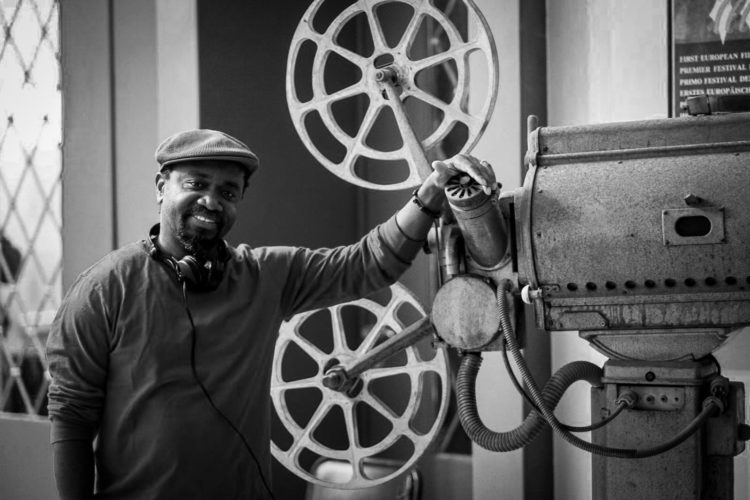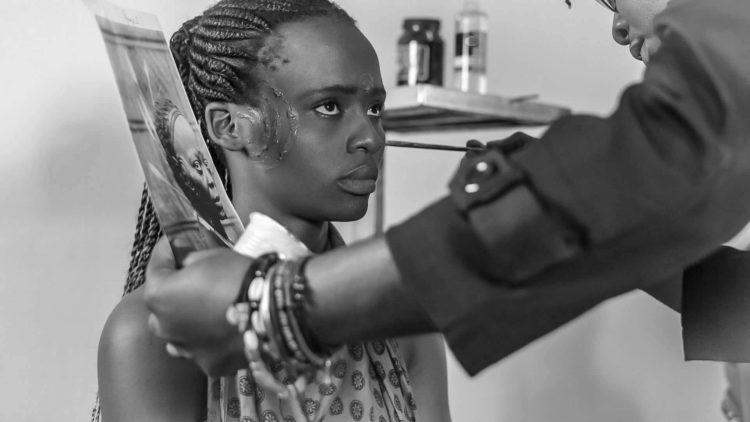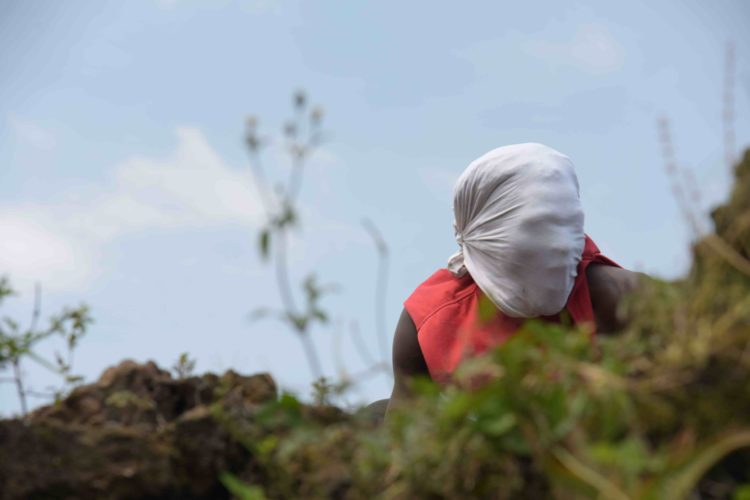Every year the Berlin International Film Festival features in its Forum Expanded section some of the most challenging propositions within experimental film and video art. One of its most stimulating and thought provoking positions this year was Matata, directed by Petna Ndaliko Katondolo and produced by Chérie Rivers Ndaliko.
The film, which was shot in the Democratic Republic of Congo, finds its foundation in the workshops held by the artists under the title “Decomposing the colonial gaze.” Those workshops were structured along four primary steps: decomposing, replication, contradiction and creative expression.
While loosely structured along those steps, Matata first and foremost shares questions about how a decomposed colonial gaze could constitute itself. It resists a purely critical approach, understanding that critique cannot but center its own object. Critique is parasitic in the sense that it depends on its object of critique in order to exist. Instead, the artists propose a communal and reparative approach by imagining an elsewhere beyond entanglements with the colonial gaze.
The film, which is 37-minutes long, demands to be met on its own terms. It chooses not to do translation work for audiences through voice over, dialogue or written text. It centers itself and its subjects, asking those spectators furthest away from it to take steps towards it. Whilst it does not make itself transparent to all perspectives, it does not frame opacity as a goal, either. Rather, it assumes the right to opacity as a fundamental requirement for encounters.
Its form, perceived by some as refusal—and in a certain sense it surely is—is primarily an offering… offering circular movements and slow layerings that consider time differently. A genderless angel (Dorine Mokha) dances elegantly within a white-walled museum full of posters arranged along a colonialist timeline, and finally turns towards the wooden structure of a windowless window frame.
Even though it strongly relies on improvisation, the film is not “experimental.” It is simply not normatively linear and knowable in the ways it makes use of the filmic timeline. The artists consider the ancient culture of proverbs to structure history and storytelling, not as a resurrection of past ways of communicating, but as a form of inquiry and dialogue that links past, present, and future. Moreover, the recursion of proverbs is a reminder of the many and diverse sources of knowledge in the world.
Matata departs from reflections on the photographic legacy of missionary Alice Seeley Harris, and is produced in partnership with the University of Nottingham, which holds Harris’s archive. Her work is regarded as an early example of the use of photography as a medium to advocate for social justice. Whilst pleading for the abolition of slavery, her photographic perspective simultaneously reveals her inherent belief in European superiority over the Congolese subjects in her photographs.
This is only a contradiction at first glance, since this particular combination of convictions reflects clearly in the photographic continuities within the diachronic entanglements between imperial and post-imperial ways of looking. Harris’ photographic images taken during times of King Léopold II’s brutal colonial rule of Congo (1885-1908) are little different from the photographic angles chosen by contemporary NGOs in the sense that both legitimize their subjects only through the lens of suffering.
Such ways of looking establish and solidify a hierarchy and mark empathy and compassion as affects fundamental to shaping a Western constitution of the world as such. The white Western feeling of compassion relies on the continued suffering of the other, and therefore maintains the other as a normative construct. The irony of compassion manifests in an attachment to one’s own feeling that supersedes the desire to end the cause for that same emotion. Should the other’s suffering end, the basis for feeling compassion would be removed.
Harris’ pictures are superimposed into the work, they leak in like ghosts still holding power over the present in ways often disavowed, their flashes producing afterimages that reappear throughout history. To break that spell, the artists deploy movement through dance, sound, rhythm, and color as their primary artistic means, their work defying a purely cognitive reading.
To write about it seems contradictory, since language tries to fix and hold it in a manner that the film itself resists. But the film will do just like one of its protagonists does in the opening scene: it will swirl out of any such attempt to be stabilized. The film opens with a photo shoot of a fashion model by a fashionable photographer. Sarah Mukadi Kadima, who performs as the model, is dressed to replicate one of Harris’ pictures.
After she is “shot” by the photographer (Mustach Muhanya) the stillness of her image and pose awakens into dance that fluidly moves into dreamscapes full of references that link the historical with the contemporary, yet flirt with a future that may be liberated from the colonial gaze. Matata understands the colonial gaze not as exclusively linked to (neo-)colonist subjectivities, but as a gaze that can be learned, internalized, and reproduced by its subjects. This is evidently where such gazes can have some of their most long-lasting and damaging effects.
Lee Weisert’s intricate soundtrack for the film is produced from the sounds rubber can make. Dancers move in relationship with metals, stones, water, fire, and air. Tyres re-emerge throughout, carrying with them their loaded political meanings. Through movement emerge interactions with materials and elements turned resources only through centuries-long extractions within colonialism and its asymmetrical economic continuations.
Within the film such materials are approached as other than economic resource. A pick-up truck drives towards the camera and halts, its passengers descent and interact with the car through dance. As motion shifts from the machine towards the protagonists, the pick-up truck loses its primary function as a vehicle and is stripped to its materiality, highlighting its implication in such extractions, and thus approached anew through a shift in perspective.
The artists share questions through their reconfigurations, rather than answers. And even the questions are not laid out all in the open; they require to be approached by the viewer while respecting the work’s opacities as basis of communication. As such, Matata poses important questions regarding violence and vision. The self-centered Western subjectivity presumes that violence is something that can be seen, at the very least through images of its effects.
Yet the truth may be: depending on where we stand we may not be able to see all violence, and just because it cannot be seen from where we stand doesn’t mean that it doesn’t exist. Film footage of “the bridge of the railway to Matadi” resurfaces throughout the film. Around the time when the bridge was built, in the late 19th century, images of it were deployed as proof of the ostensibly civilizing and modernizing mission of Belgian colonial presence.
What these images hid were the thousands of lives taken in order to erect that bridge. Power manifests in the ability to make violence invisible, and violence underlies the illusion of one’s capacity to make everything visible, graspable and knowable. A bridge often stands as a symbol for exchange, for communication and for encounter. This leaves out the important question about the conditions under which such bridges are built, and whose ways of moving they serve.
Vika Kirchenbauer is an artist, writer and music producer based in Berlin. In her work she explores opacity in relation to representation of the ‘othered’ and discusses the role of emotions in contemporary art, labor and politics. With particular focus on affective subject formation, she examines violence as it attaches to different forms of visibility and invisibility, and considers the ways in which subjects are implicated in and situated within institutional power structures. Her film UNTITLED SEQUENCE OF GAPS was shown together with Matata at the 2020 Berlin International Film Festival’s Forum Expanded section
Petna Ndaliko Katondolo is an award-winning filmmaker and educator from the Democratic Republic of Congo. His multi-genre artistic works are acclaimed for their provocative Afrofuturistic artistic style, which engages historical content to address contemporary sociopolitical and cultural issues. He is founder and Artistic Director of the Yole!Africa cultural center and of the Congo International Film Festival. He also teaches and consults regularly for international organizations addressing social and political inequity among youth through culture and education. He is currently the Artist in Residence at the Stone Center for Black History and Culture at the University of North Carolina at Chapel Hill.
Chérie Rivers Ndaliko is an interdisciplinary scholar, writer, and activist whose focus is decoloniality. She is the author of Necessary Noise: Music, Film, and Charitable Imperialism in the East of Congo (Oxford University Press, 2016). She has also worked as writer and creative producer for films including Mabele na biso (2014), Congo: 50 ans et au-déla (2012), and Jazz Mama (2010). Dr. Ndaliko holds a Ph.D. in African Studies from Harvard University, where she was a pioneer of the University’s Social Engagement Initiative. She is currently the Director of Research and Education at Yole!Africa in Goma, DRC, and a professor of Geography at the University of North Carolina at Chapel Hill.



